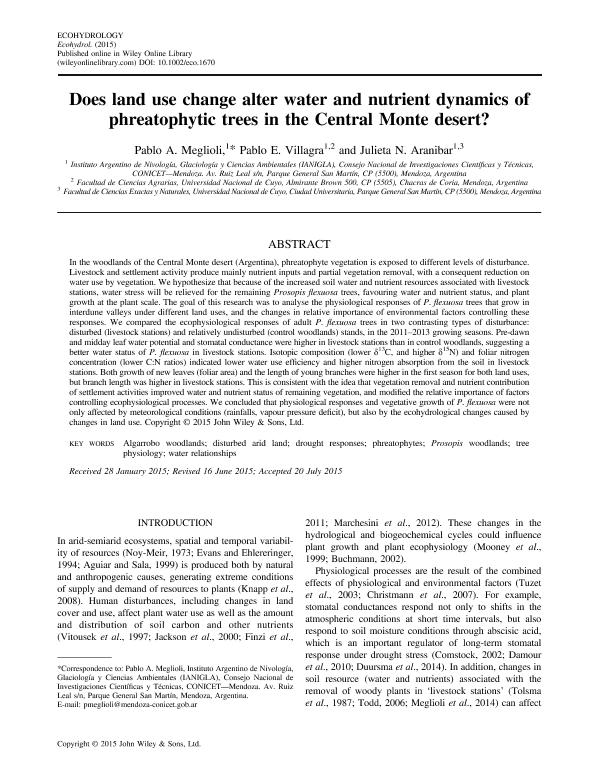Mostrar el registro sencillo del ítem
dc.contributor.author
Meglioli, Pablo Andrés

dc.contributor.author
Villagra, Pablo Eugenio

dc.contributor.author
Aranibar, Julieta Nelida

dc.date.available
2019-02-04T18:07:49Z
dc.date.issued
2016-07
dc.identifier.citation
Meglioli, Pablo Andrés; Villagra, Pablo Eugenio; Aranibar, Julieta Nelida; Does land use change alter water and nutrient dynamics of phreatophytic trees in the Central Monte desert?; John Wiley & Sons Inc; Ecohydrology; 9; 5; 7-2016; 738-752
dc.identifier.issn
1936-0584
dc.identifier.uri
http://hdl.handle.net/11336/69322
dc.description.abstract
In the woodlands of the Central Monte desert (Argentina), phreatophyte vegetation is exposed to different levels of disturbance. Livestock and settlement activity produce mainly nutrient inputs and partial vegetation removal, with a consequent reduction on water use by vegetation. We hypothesize that because of the increased soil water and nutrient resources associated with livestock stations, water stress will be relieved for the remaining Prosopis flexuosa trees, favouring water and nutrient status, and plant growth at the plant scale. The goal of this research was to analyse the physiological responses of P. flexuosa trees that grow in interdune valleys under different land uses, and the changes in relative importance of environmental factors controlling these responses. We compared the ecophysiological responses of adult P. flexuosa trees in two contrasting types of disturbance: disturbed (livestock stations) and relatively undisturbed (control woodlands) stands, in the 2011–2013 growing seasons. Pre-dawn and midday leaf water potential and stomatal conductance were higher in livestock stations than in control woodlands, suggesting a better water status of P. flexuosa in livestock stations. Isotopic composition (lower δ13C, and higher δ15N) and foliar nitrogen concentration (lower C:N ratios) indicated lower water use efficiency and higher nitrogen absorption from the soil in livestock stations. Both growth of new leaves (foliar area) and the length of young branches were higher in the first season for both land uses, but branch length was higher in livestock stations. This is consistent with the idea that vegetation removal and nutrient contribution of settlement activities improved water and nutrient status of remaining vegetation, and modified the relative importance of factors controlling ecophysiological processes. We concluded that physiological responses and vegetative growth of P. flexuosa were not only affected by meteorological conditions (rainfalls, vapour pressure deficit), but also by the ecohydrological changes caused by changes in land use. Copyright © 2015 John Wiley & Sons, Ltd.
dc.format
application/pdf
dc.language.iso
eng
dc.publisher
John Wiley & Sons Inc

dc.rights
info:eu-repo/semantics/openAccess
dc.rights.uri
https://creativecommons.org/licenses/by-nc-sa/2.5/ar/
dc.subject
Algarrobo Woodlands
dc.subject
Disturbed Arid Land
dc.subject
Drought Responses
dc.subject
Phreatophytes
dc.subject
Prosopis Woodlands
dc.subject
Tree Physiology
dc.subject
Water Relationships
dc.subject.classification
Otras Ciencias Biológicas

dc.subject.classification
Ciencias Biológicas

dc.subject.classification
CIENCIAS NATURALES Y EXACTAS

dc.title
Does land use change alter water and nutrient dynamics of phreatophytic trees in the Central Monte desert?
dc.type
info:eu-repo/semantics/article
dc.type
info:ar-repo/semantics/artículo
dc.type
info:eu-repo/semantics/publishedVersion
dc.date.updated
2019-02-04T13:16:03Z
dc.journal.volume
9
dc.journal.number
5
dc.journal.pagination
738-752
dc.journal.pais
Estados Unidos

dc.journal.ciudad
Nueva York
dc.description.fil
Fil: Meglioli, Pablo Andrés. Consejo Nacional de Investigaciones Científicas y Técnicas. Centro Científico Tecnológico Conicet - Mendoza. Instituto Argentino de Nivología, Glaciología y Ciencias Ambientales. Provincia de Mendoza. Instituto Argentino de Nivología, Glaciología y Ciencias Ambientales. Universidad Nacional de Cuyo. Instituto Argentino de Nivología, Glaciología y Ciencias Ambientales; Argentina
dc.description.fil
Fil: Villagra, Pablo Eugenio. Consejo Nacional de Investigaciones Científicas y Técnicas. Centro Científico Tecnológico Conicet - Mendoza. Instituto Argentino de Nivología, Glaciología y Ciencias Ambientales. Provincia de Mendoza. Instituto Argentino de Nivología, Glaciología y Ciencias Ambientales. Universidad Nacional de Cuyo. Instituto Argentino de Nivología, Glaciología y Ciencias Ambientales; Argentina. Universidad Nacional de Cuyo. Facultad de Ciencias Agrarias; Argentina
dc.description.fil
Fil: Aranibar, Julieta Nelida. Consejo Nacional de Investigaciones Científicas y Técnicas. Centro Científico Tecnológico Conicet - Mendoza. Instituto Argentino de Nivología, Glaciología y Ciencias Ambientales. Provincia de Mendoza. Instituto Argentino de Nivología, Glaciología y Ciencias Ambientales. Universidad Nacional de Cuyo. Instituto Argentino de Nivología, Glaciología y Ciencias Ambientales; Argentina. Universidad Nacional de Cuyo. Facultad de Ciencias Exactas y Naturales; Argentina
dc.journal.title
Ecohydrology

dc.relation.alternativeid
info:eu-repo/semantics/altIdentifier/doi/https://dx.doi.org/10.1002/eco.1670
dc.relation.alternativeid
info:eu-repo/semantics/altIdentifier/url/https://onlinelibrary.wiley.com/doi/abs/10.1002/eco.1670
Archivos asociados
